These coffee macarons are made with chewy espresso shells and filled with a creamy espresso french buttercream. They're truly every coffee lovers dream!
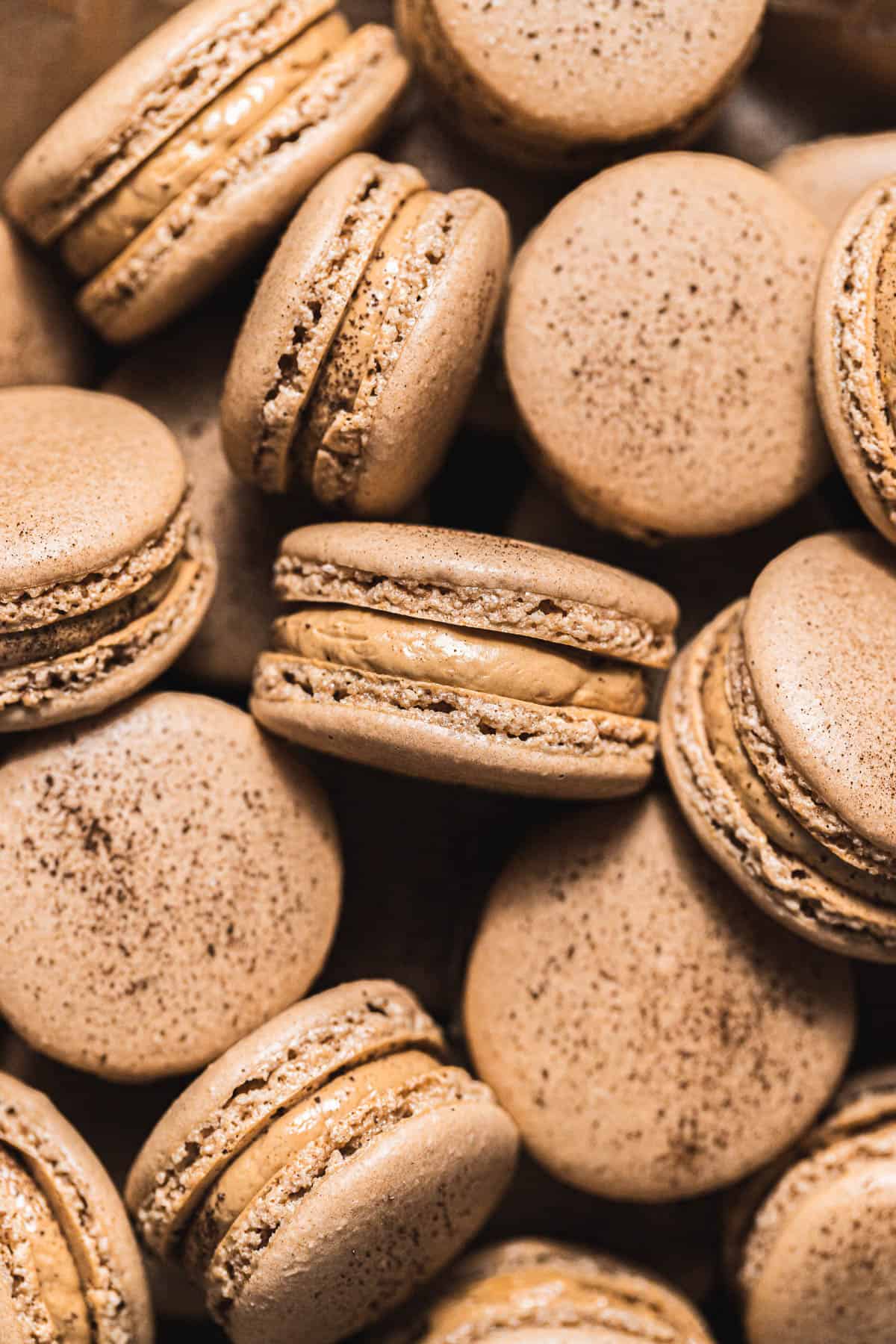
These coffee macarons are made with my tried and true macaron base recipe with espresso paste mixed into the meringue, and they are absolutely heavenly! The chewy shell combined with the creamy french buttercream, and a strong coffee flavor all around... SO GOOD.
If you've never made macarons before, do not fear! I have laid out all of my tips in tricks, along with process photos, throughout the post 🙂 I promise macarons are not as difficult to make as they seem!
For more macaron recipes, try Chai Macarons, Salted Caramel Macarons, Lemon Macarons, and Birthday Cake Macarons.
Jump to Recipe
Why you'll love these coffee macarons
- Strong Coffee Flavor: These macs are packed with coffee flavor, thanks to the espresso paste in both the shells and the buttercream!
- Swiss Method: The macaron shells are made with a base of sturdy swiss meringue, making them nearly foolproof!
- Creamy French Buttercream: French buttercream is made with a base of egg yolks, making it almost custard-like. AND, this recipe calls for 3 egg yolks, so you can use the yolks from the whites used for the macaron shells! So no sad egg yolks sitting around in your fridge 🙂
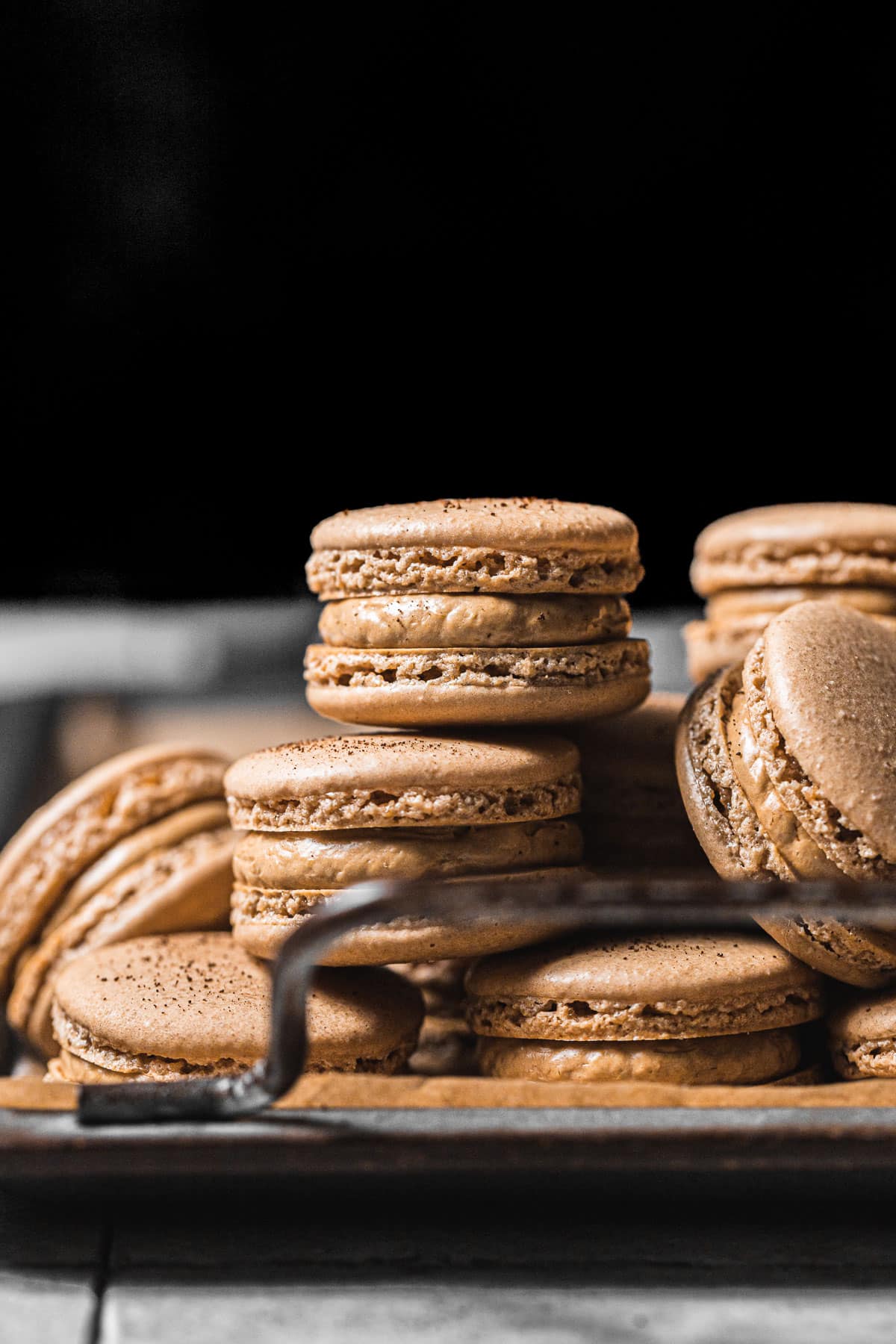
Ingredient Notes
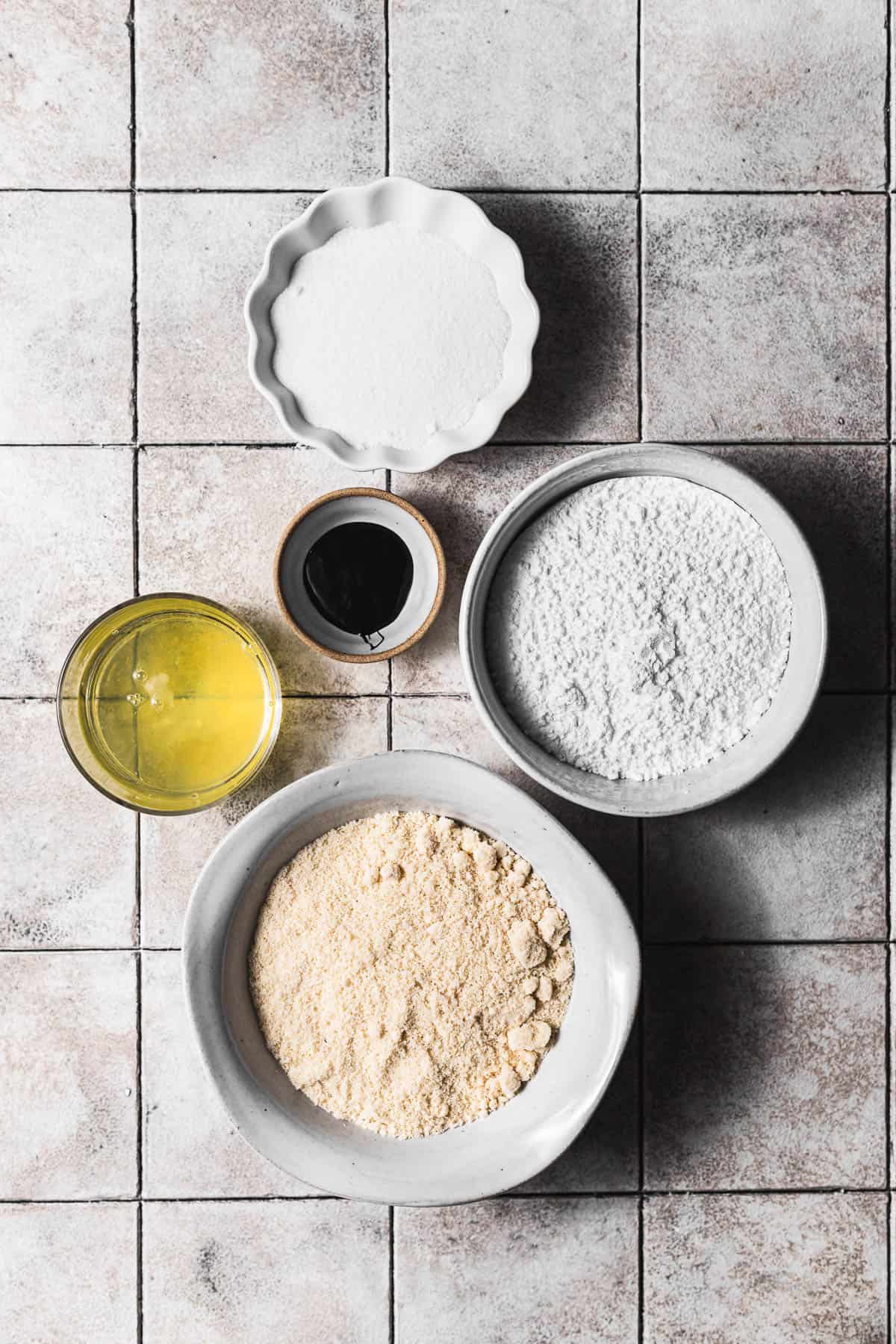
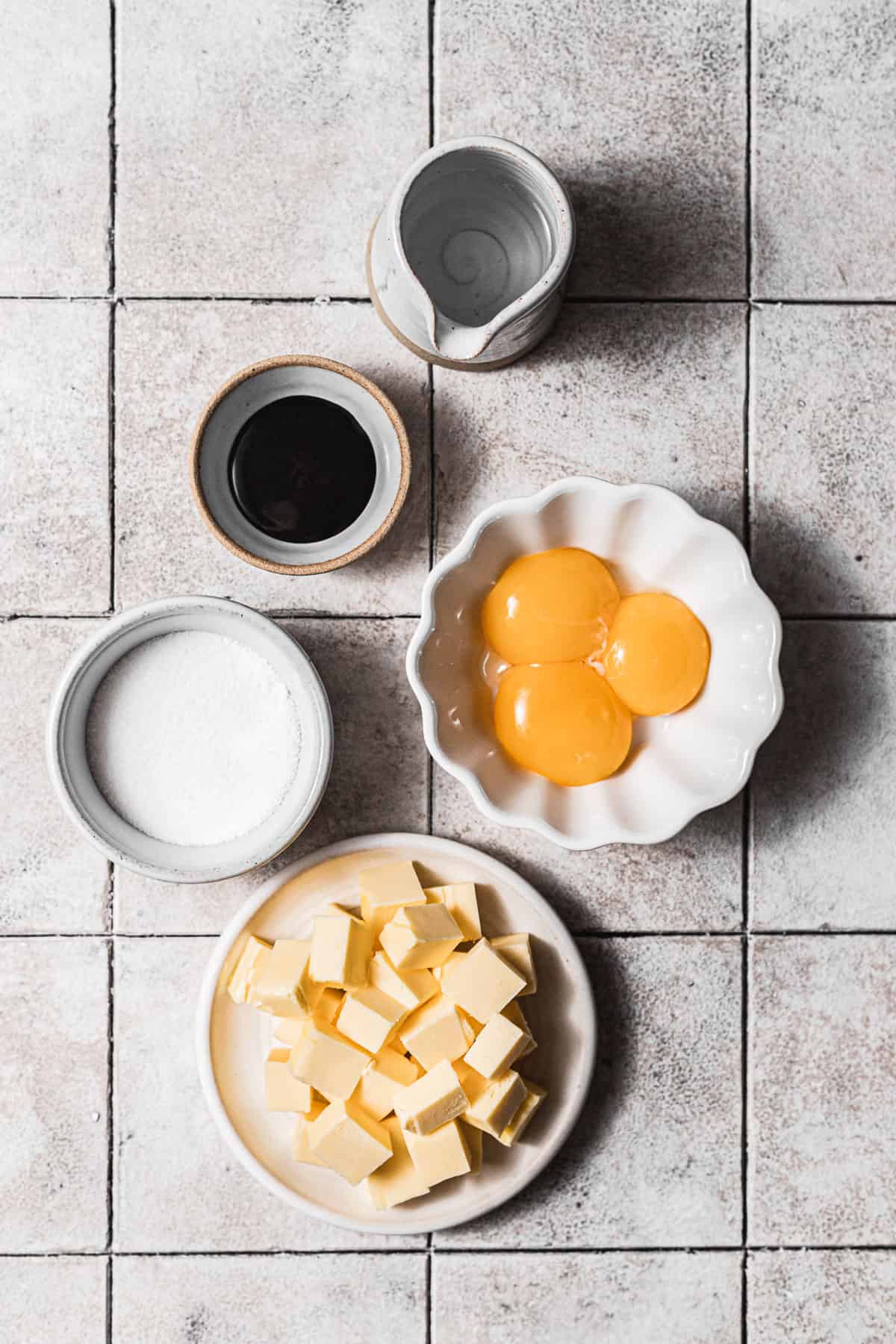
- White Vinegar: To ensure that your meringue remains stable, clean and wipe down all appliances with white vinegar.
- Powdered Sugar: You’ll need powdered sugar for the macaron shells.
- Almond Flour: Be sure to use extra fine almond flour to get those super smooth shells!
- Egg Whites: You’ll need about 3 egg whites. Don’t worry about bringing them to room temperature because you’ll just heat them up over a double boiler to make a swiss meringue!
- Granulated Sugar: The sugar is going to be added into the egg whites when making the swiss meringue. It will only take a couple minutes for the sugar to dissolve into the egg whites, so watch carefully!
- Egg Yolks: I love pairing a french buttercream with macarons, because my recipe calls for an equal amount of yolks and whites that are used for the shells.
- Unsalted Butter: For the buttercream, use unsalted room temperature butter.
- Espresso Powder or Paste: I used espresso paste, but an equal amount of espresso powder works just as well!
See recipe card for full information on ingredients and individual quantities.
Step by Step Instructions
Here are step by step photos and instructions on how to make this coffee macaron recipe! For the full ingredient list and method, see the recipe card at the end of this post.
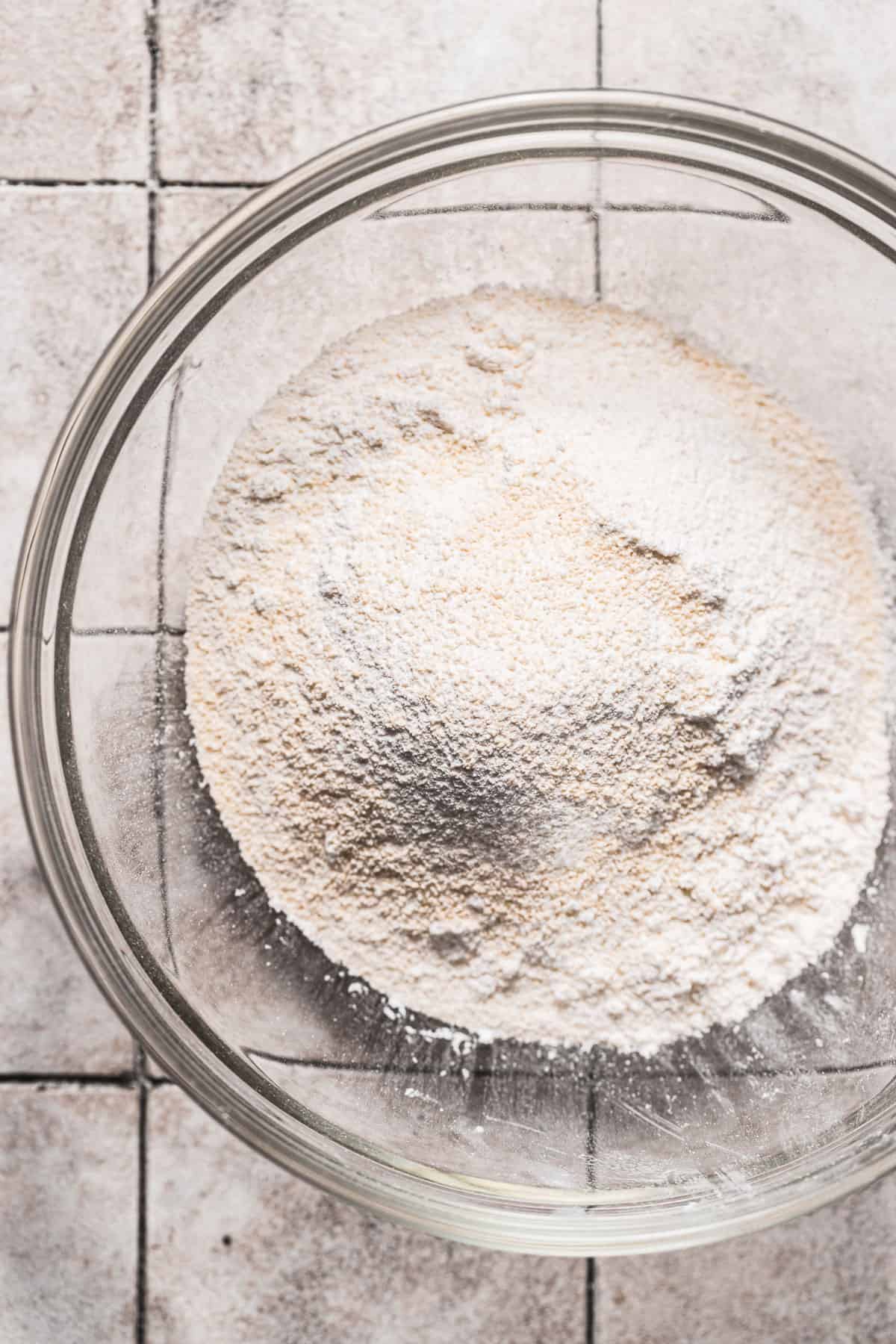
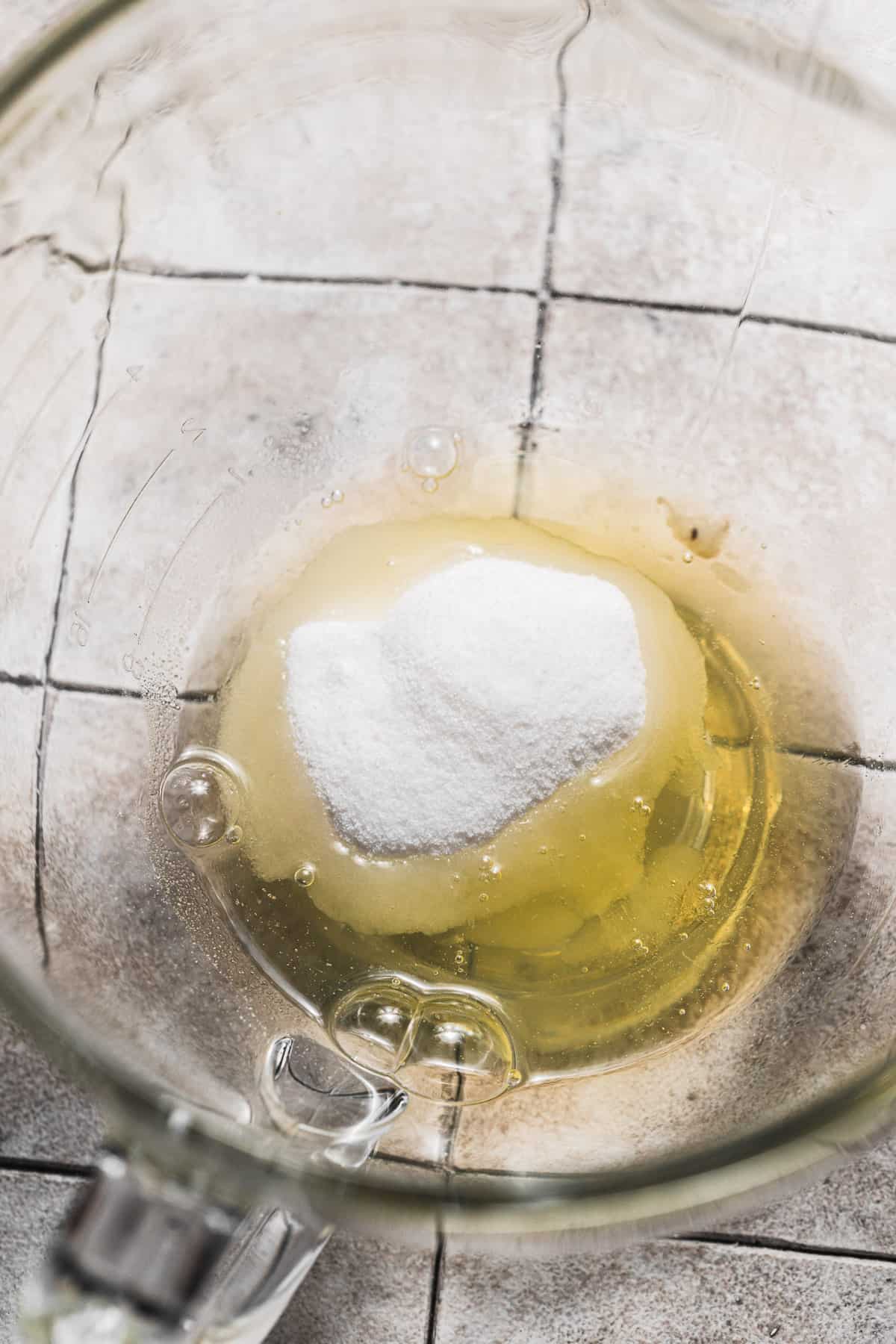
STEP 1: Sift the dry ingredients. In a medium bowl, sift the almond flour and powdered sugar, twice.
STEP 2: Place egg whites & sugar over double boiler. Next, heat the egg whites and granulated sugar over a double boiler until the sugar has dissolved or until the temperature is about 120 degrees F.
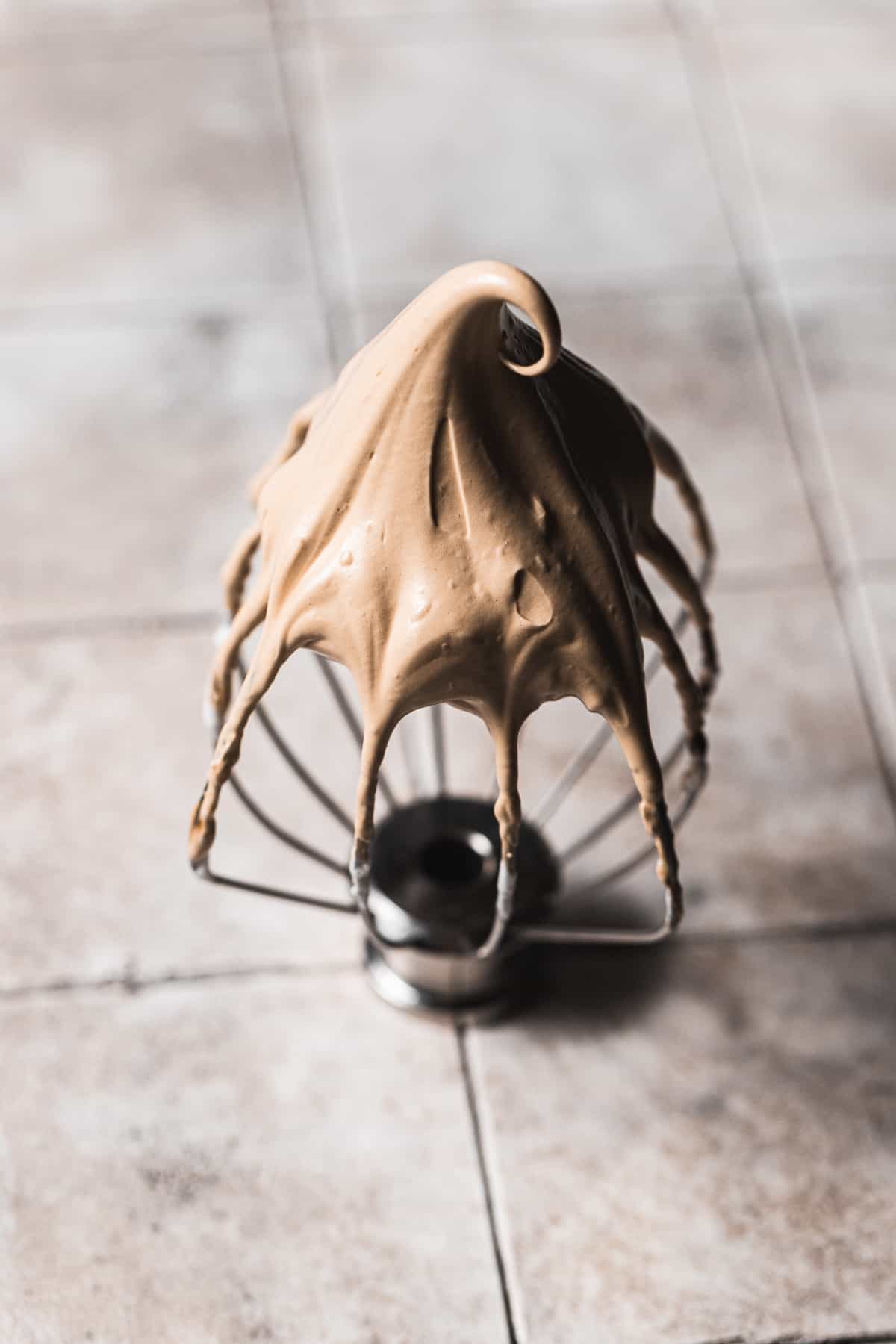
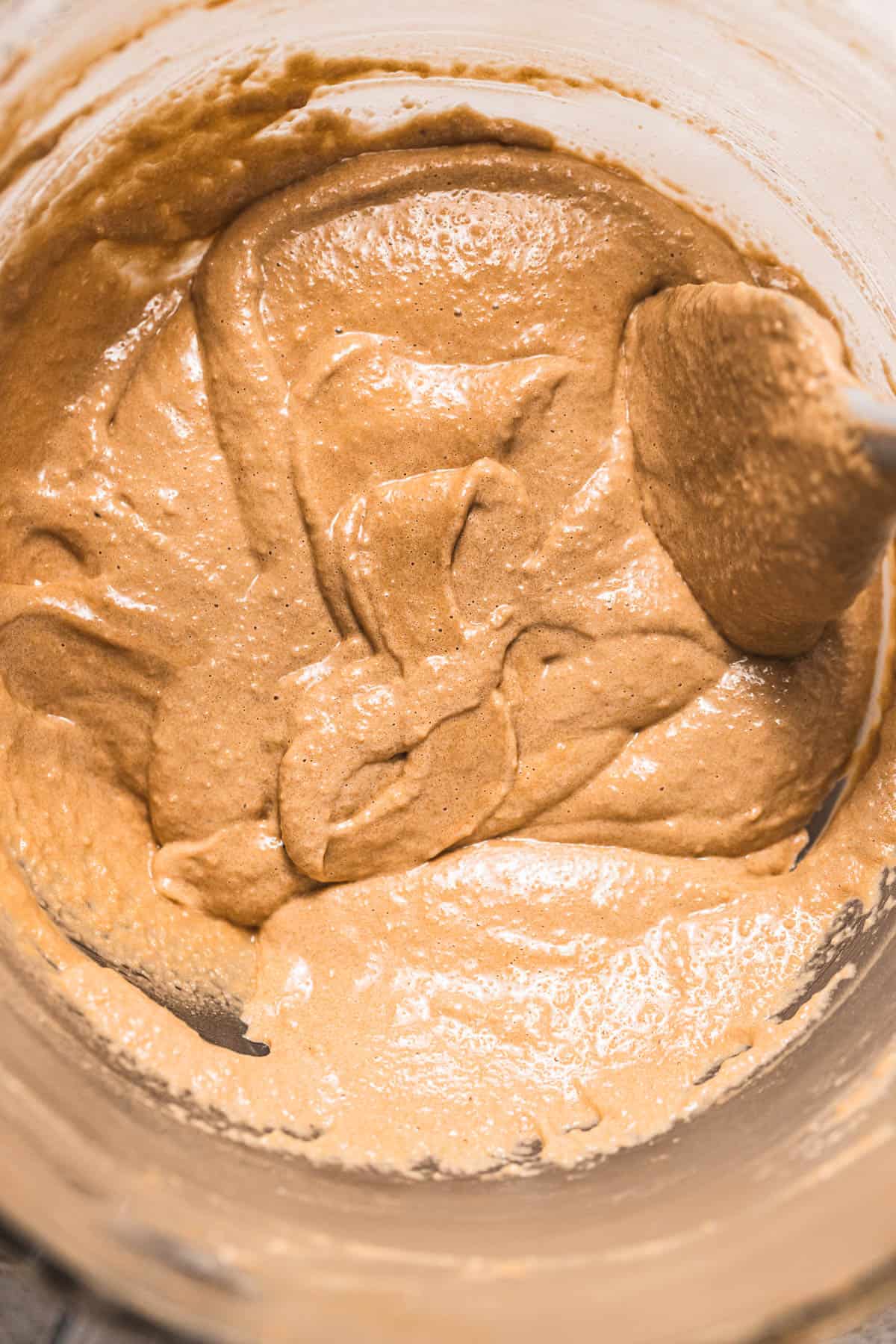
STEP 3: Whip the meringue to stiff peaks. Transfer the egg white mixture to a large bowl or a bowl of a stand mixer fitted with a whisk attachment. Whisk until the mixture reaches soft peaks. At this point, you can add the espresso paste. Continue whisking the meringue until stiff peaks form.
STEP 4: Add the dry ingredients to the meringue. Start the macaronage by folding in ⅓ of the dry ingredients. Mix carefully with a silicone spatula by scraping around the sides of the bowl, then through the middle of the batter. Add the remainder of the dry ingredients, folding with the same gentle method. Once the dry ingredients are fully incorporated, begin spreading the batter along the sides of the bowl to deflate it slightly. Continue scraping around the sides of the bowl and through the middle. The mixture is ready when you can draw several figure eights without the batter breaking.
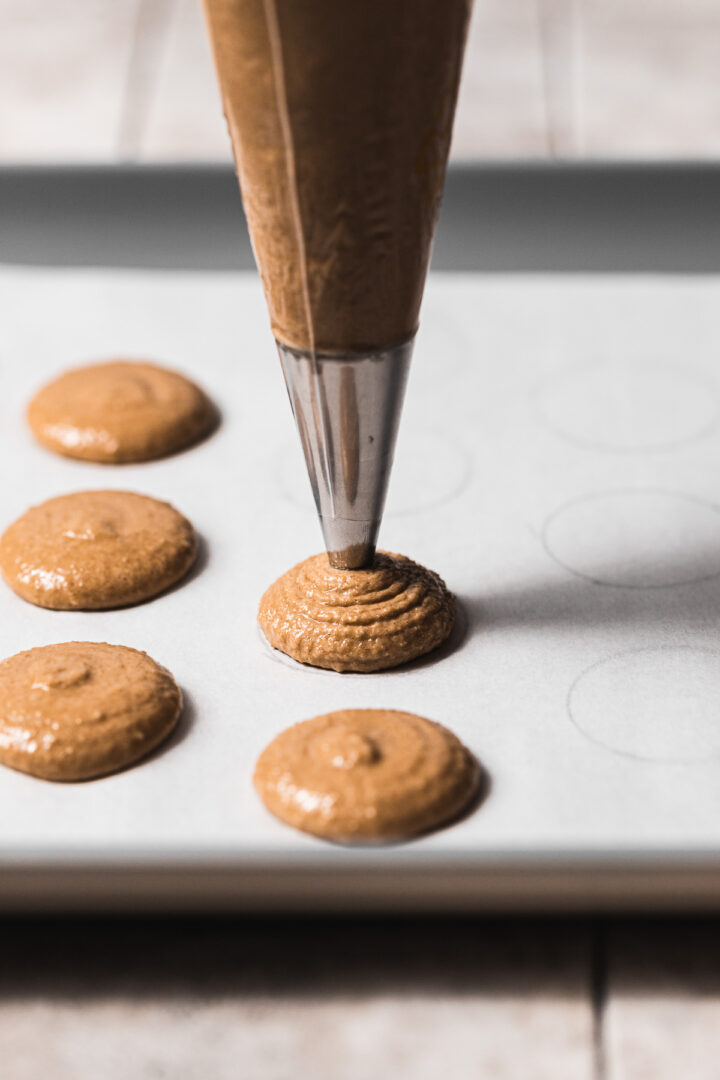
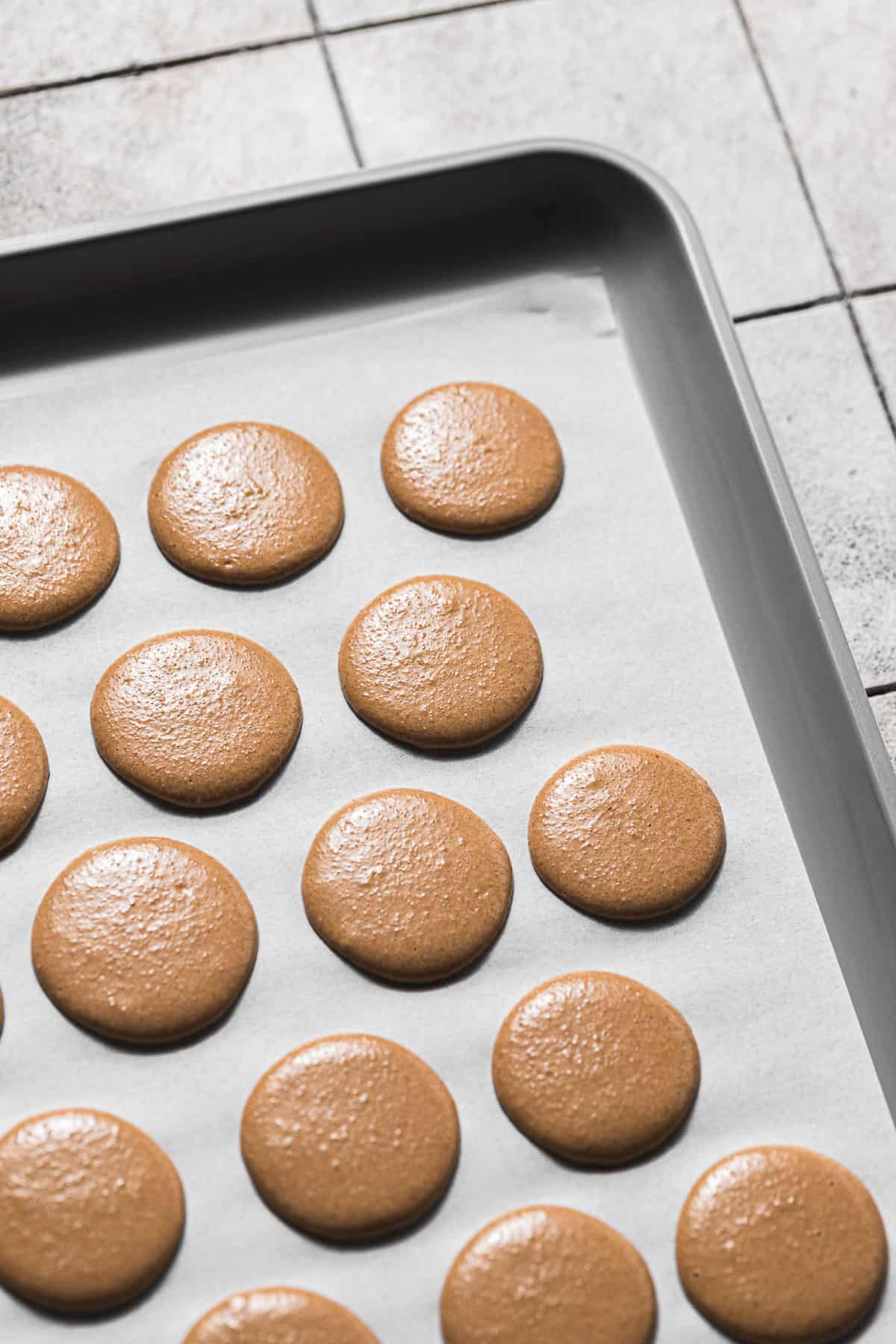
STEP 5: Pipe the macaron batter. Transfer the batter to a piping bag with a small round piping tip (I used Ateco 802). Place your macaron template under another piece of parchment paper on a baking sheet and pipe perpendicular to fill in each circle.
STEP 6: Release air bubbles and rest. Carefully remove the template and tap the baking sheet on the on counter a few times in order to release any air bubbles. It also helps to bang on the bottom of the baking sheet with your hand. Let the macarons rest for about 30-40 minutes, or until they are dry and no longer sticky to the touch.
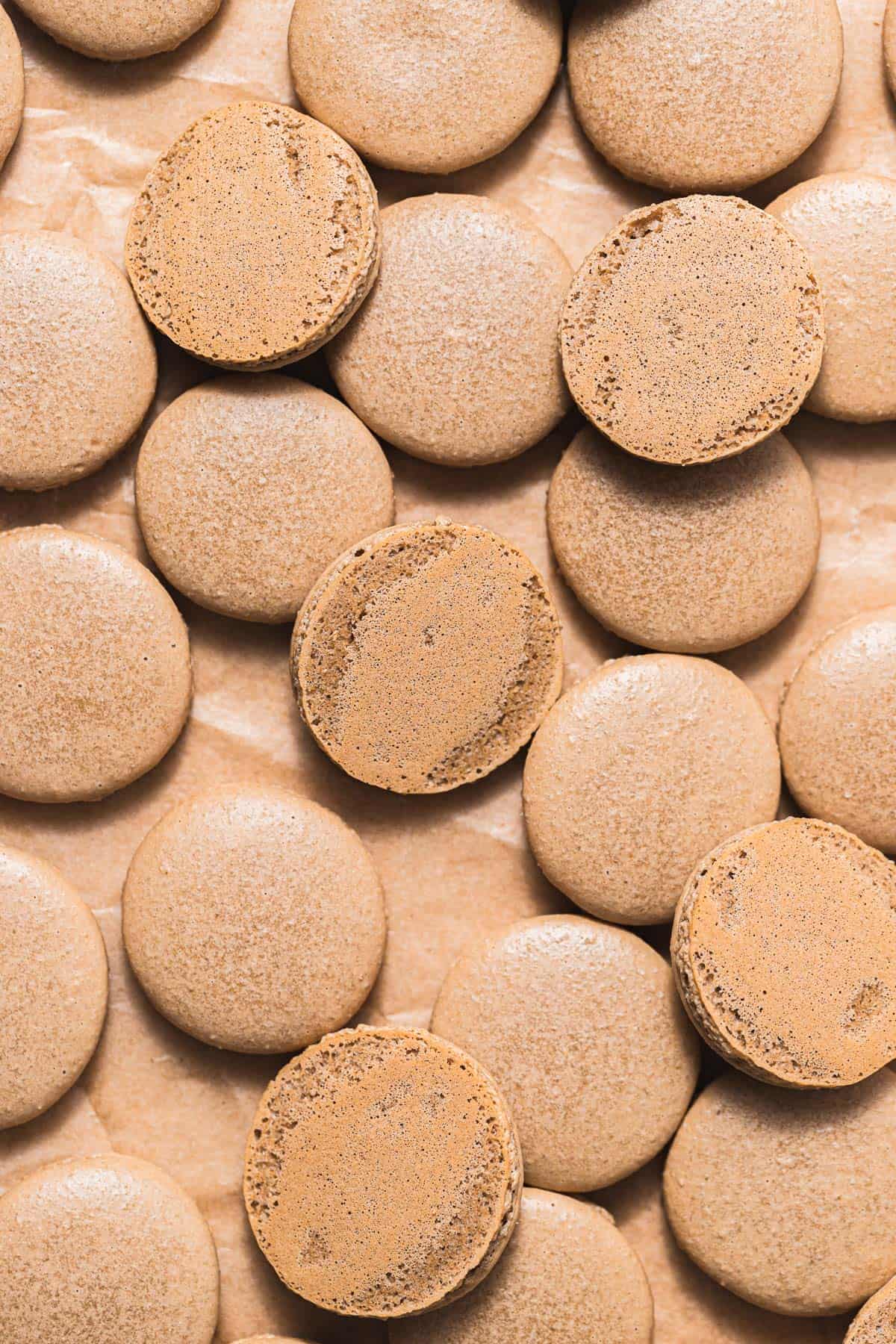
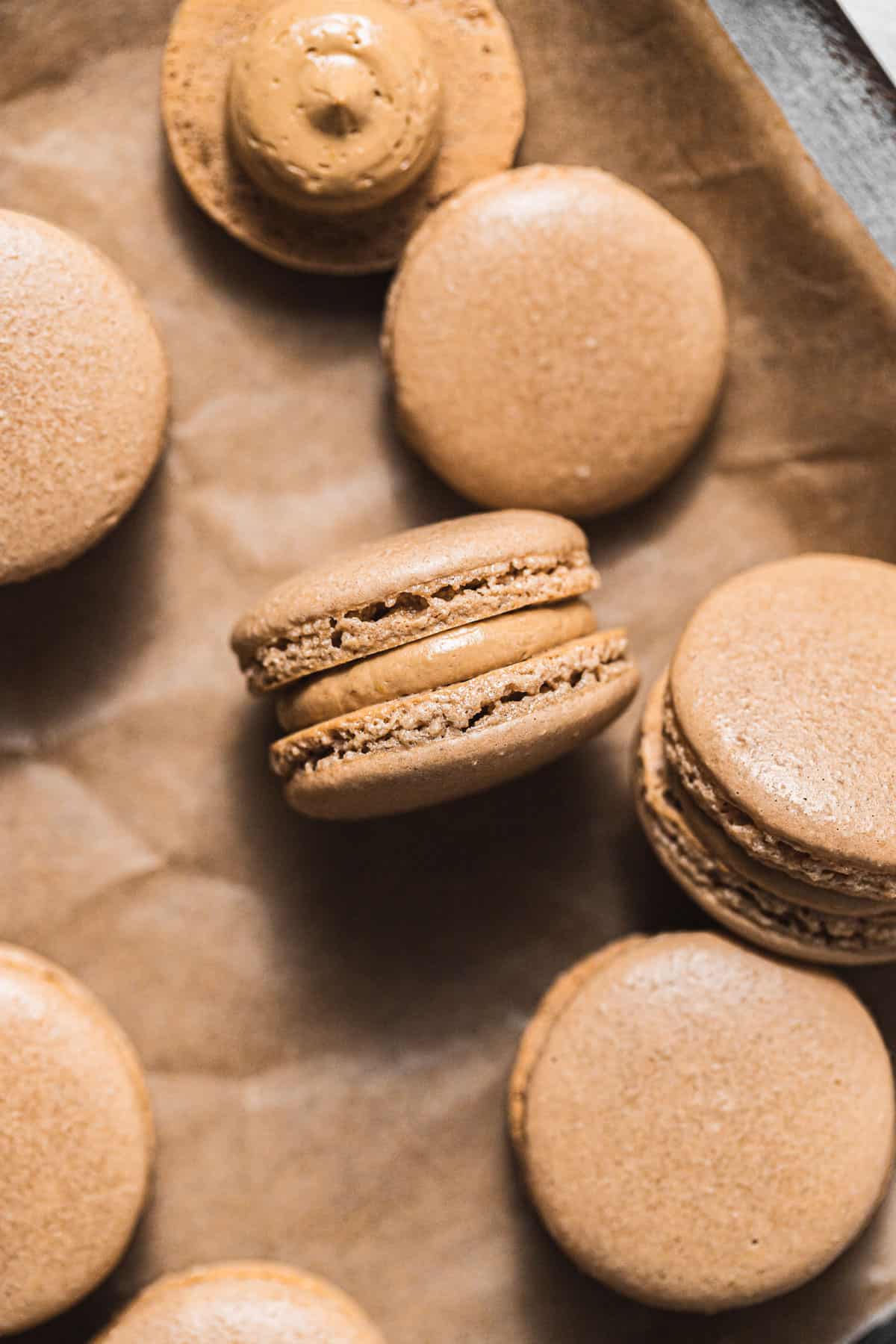
STEP 7: Bake. Bake the macarons for about 12-14 minutes. Allow to cool completely before peeling them off of the parchment paper.
STEP 8: Make the buttercream & assemble. Make the french buttercream and transfer to a piping bag fitted with a small round tip (I used Ateco 803). Pair the macarons up and pipe the buttercream onto the bottom shell. Place the paired shell on top, pressing down slightly to ensure they stick together. Place in the fridge until ready to serve.
Expert Baking Tips
- Wipe down appliances with vinegar. Before making the macaron shells, wipe all appliances down with white vinegar to ensure they're clean and nothing with hinder the egg whites from wiping up.
- Freeze the shells after baking. If you have trouble peeling the macarons off of the parchment once they have cooled, pop them into the freezer for a few minutes and they should come off easily.
- Chill the macarons. The flavor of macaron shells develop more by the second day, so I recommend making them the day before and chilling them overnight, then assemble the next day.
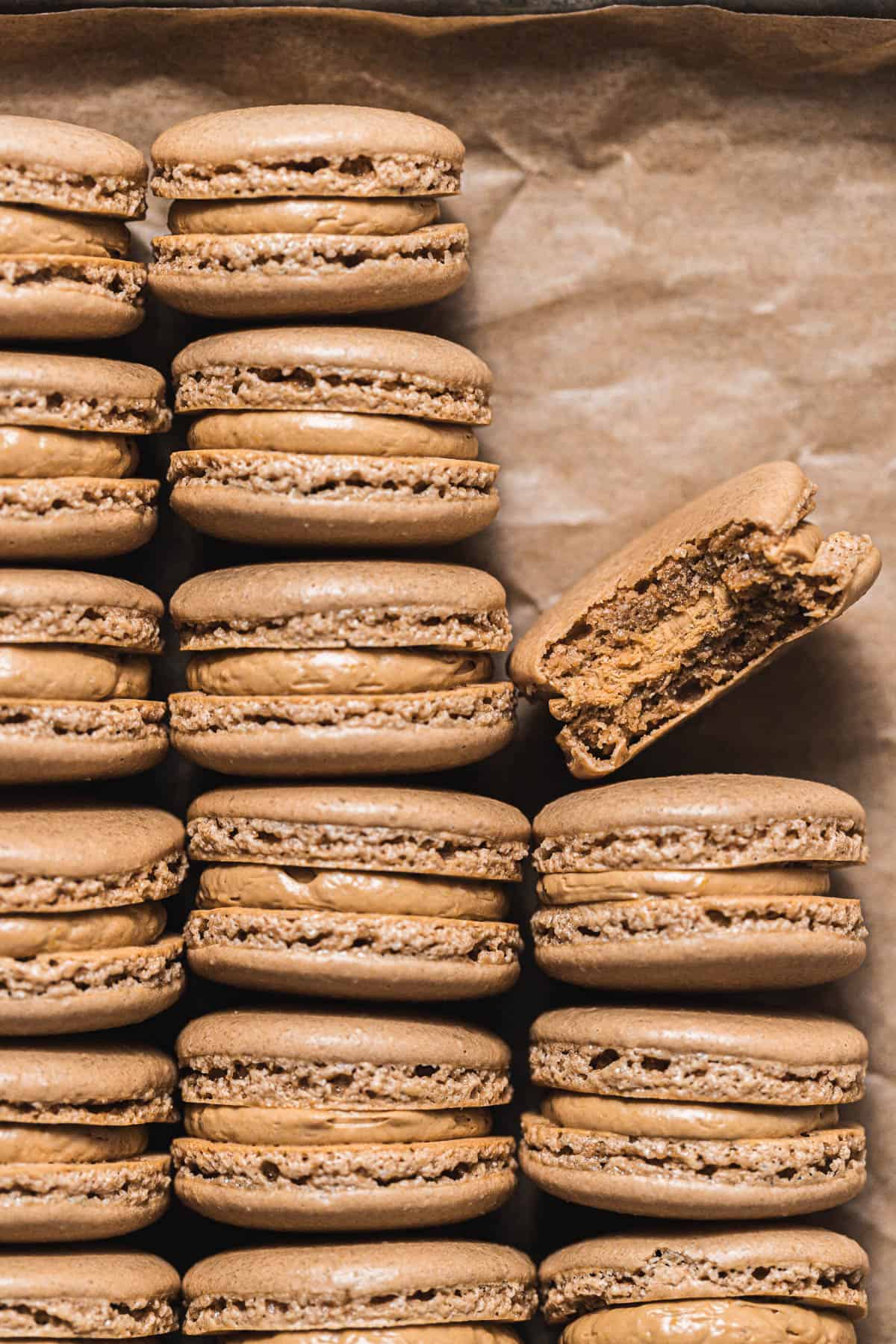
6 Essential Macaron Rules
- Wipe down all bowls and appliances with white vinegar. This will ensure that everything is spotlessly clean and nothing will hinder the stability of the meringue.
- Beat the meringue until STIFF peaks form. The best way to test this is to turn the bowl upside down to make sure that the meringue is stable enough and does not move at all.
- SIFT SIFT SIFT! You need to sift the powdered sugar and almond flour twice to get those smooth macaron shells!
- Mix the batter with a silicone spatula by circling around and straight through the middle. Once all of the dry ingredients are incorporated, deflate the macaron batter by spreading it against the sides of the bowl. This will ensure that the shells do not come out hollow.
- Test the consistency of the batter frequently by drawing a figure eight with the silicone spatula. You should be able to draw a figure eight a few times in a row without the batter breaking. This is how you know the batter is ready to be piped onto a baking sheet.
- Allow the macarons to rest long enough before going into the oven. I would recommend 30-40 minutes of rest time before baking. As they rest, a skin forms on the surface, which is what forces the macarons to bake upwards and grow feet!
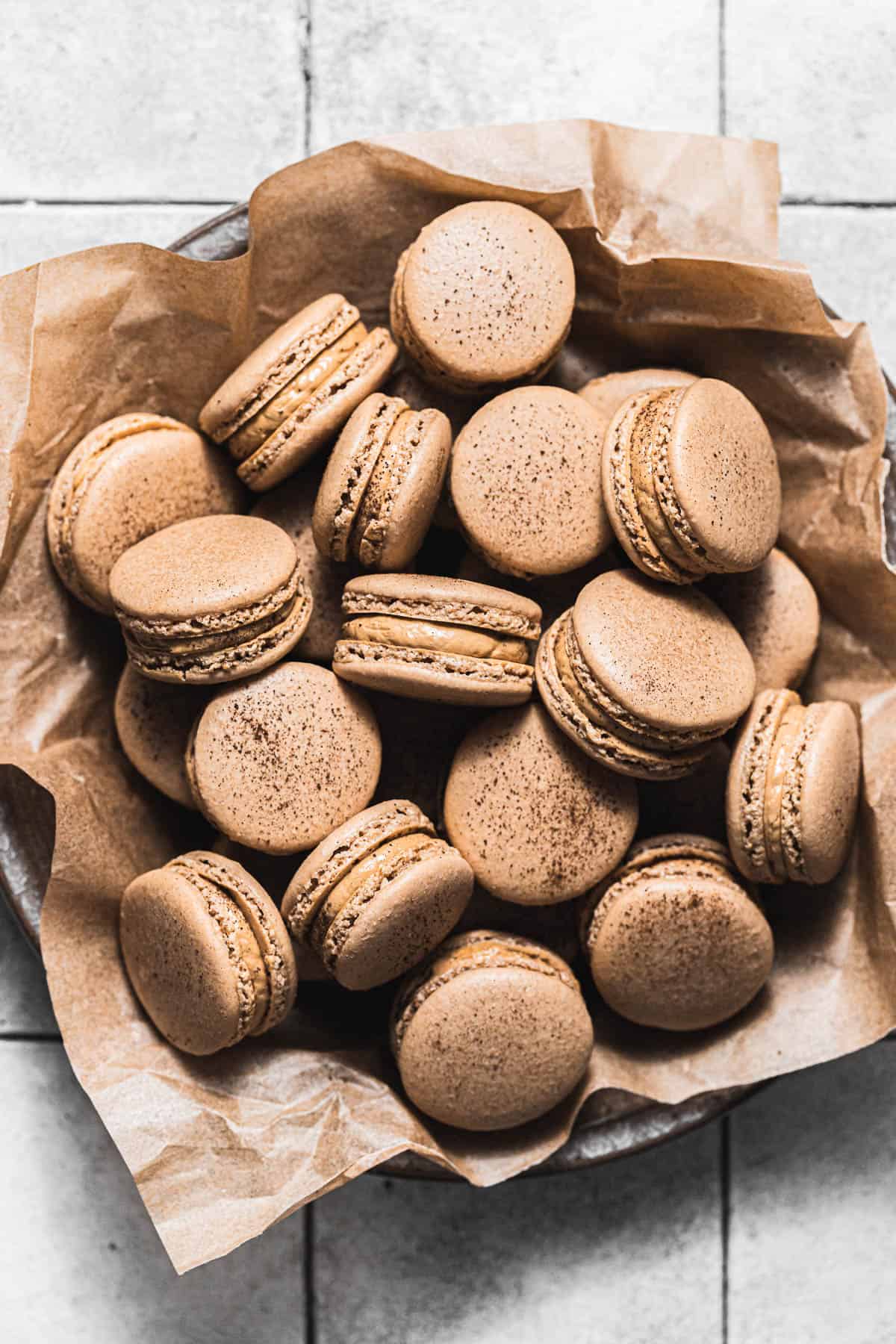
Recipe FAQs
The swiss meringue method is my preferred method for making macarons, as it is the simplest and most stable meringue, in my opinion. The egg whites and sugar are combined in one bowl and heated over a double boiler with simmering water until it reaches 120 degrees F. Slightly heating the egg whites stablizes the meringue, which will increase your chances of achieving the correct consistency of macaron batter.
The key is to make sure the batter is mixed properly and the meringue is deflated enough. Once all of the dry ingredients are incorporated, deflate the macaron batter by spreading it against the sides of the bowl. This will ensure that the shells do not come out hollow.
Allow the macarons to rest long enough before going into the oven. I would recommend 30-40 minutes of rest time before baking. As they rest, a skin forms on the surface, which is what forces the macarons to bake upwards and grow feet!
Macarons require a low temperature for baking. I recommend baking them at 300 degrees F for about 12 minutes.
Macarons will last for a few days at room temperature and up to a week in the fridge. I prefer to store them in the fridge not only so they will last longer, but also because I find that they taste even better cold.
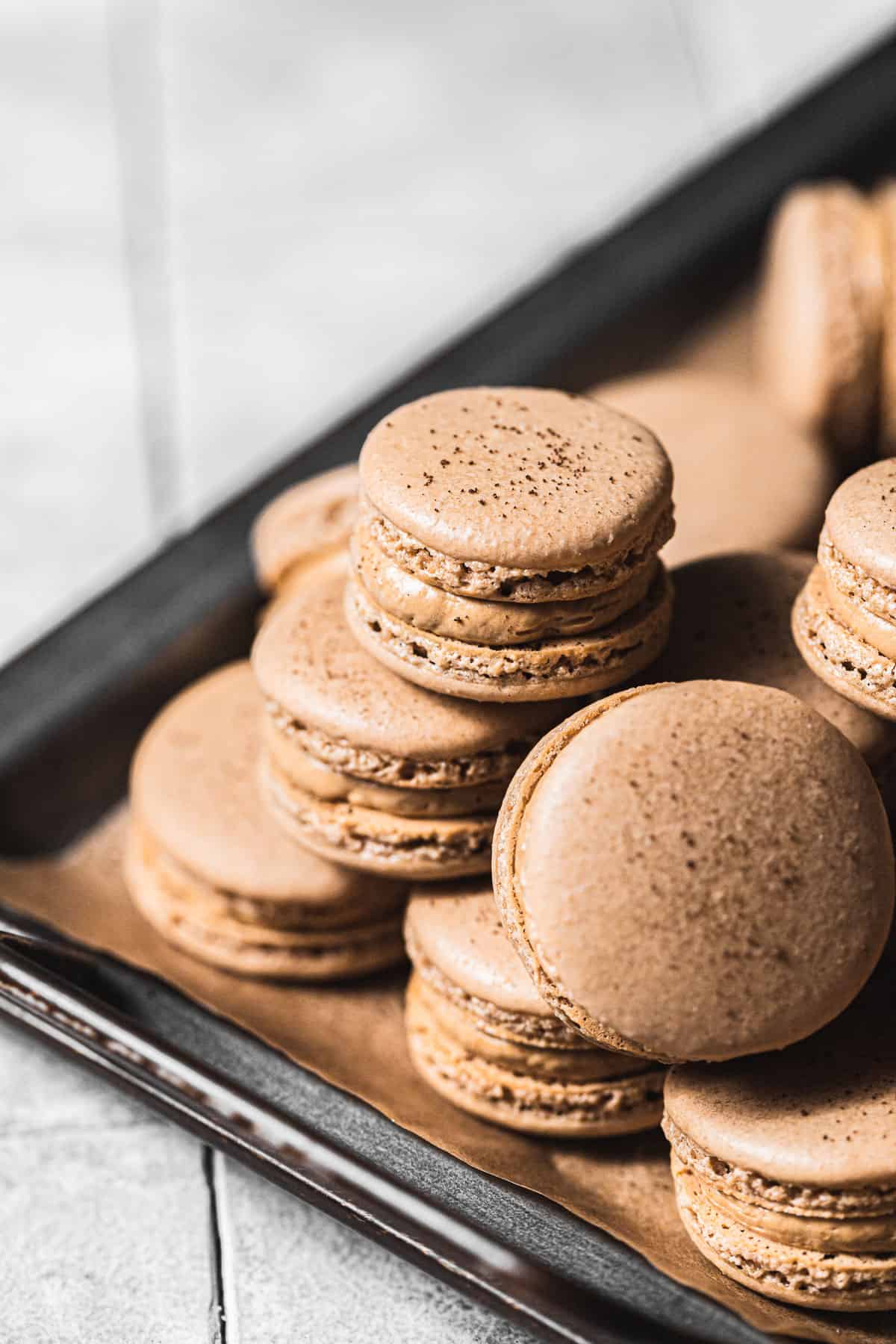
Baking in Grams
All of the recipes on this blog are carefully developed with gram measurements so you can easily recreate them in your own kitchen with success. Volume measurements are extremely inaccurate and leave room for significant errors. Not all measuring cups are made equally, so your one cup of flour will be different from my one cup of flour. By providing precise measurements in grams (aside from minor ingredients, which are given in tsp/tbsp), you can make these recipes accurately and with less cleanup! All you need is this kitchen scale.
If this still isn't enough to convince you, I have provided volume measurements in the recipe card. If you are interested in understanding the conversions, this is the best conversion chart.
But trust me, once you try baking in grams you'll never turn back!
Happy baking! x
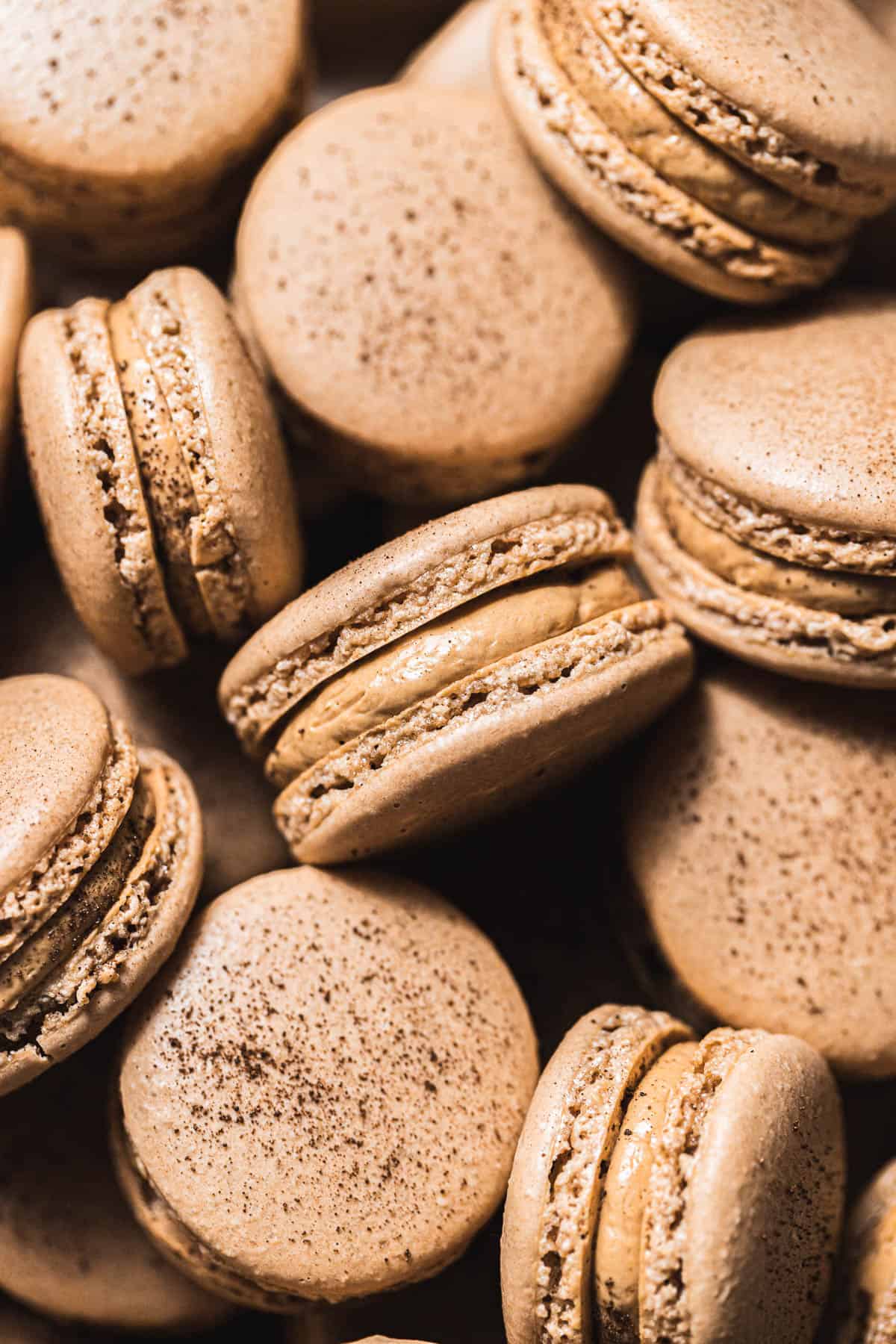
Other macaron recipes to try
If you tried this recipe, I'd love to know how it turned out for you! Leave a star rating & review below and post a picture (or video!) on Instagram and tag me so I can see your bakes! Not ready to make this recipe yet? Click the heart button on the right of your screen to save it for later 🙂
📖 Recipe
Coffee Macarons
Ingredients
For the Macaron Shells:
- 130 g powdered sugar
- 120 g almond flour
- 105 g about 3 egg whites
- 100 g granulated sugar
- 1 teaspoon espresso paste or powder
For the French Buttercream:
- 3 egg yolks
- 50 g granulated sugar
- 1 ½ tablespoon water
- 113 g unsalted butter, room temp
- ½ teaspoon vanilla extract
- 1 teaspoon espresso paste or powder
Instructions
For the Macaron Shells:
- Prepare a macaron template by using a large piping tip or small round cookie cutter of about 1 ½″ in size to trace circles about 2 inches apart on one sheet of parchment paper. You will place this under another piece of parchment paper when ready to pipe the macaron shells.
- In a medium bowl, sift the almond flour and powdered sugar, twice.
- Next, heat the egg whites and granulated sugar over a double boiler until the sugar has dissolved or until the temperature is about 120 degrees F.
- Transfer the egg white mixture to a large bowl or a bowl of a stand mixer fitted with a whisk attachment. Whisk until the mixture reaches soft peaks. At this point, you can add the espresso paste.
- Continue whisking the meringue until stiff peaks form.
- Start the macaronage by folding in ⅓ of the dry ingredients. Mix carefully with a silicone spatula by scraping around the sides of the bowl, then through the middle of the batter. Do this a few times until it is mostly combined.
- Add the remainder of the dry ingredients, folding with the same gentle method. Once the dry ingredients are fully incorporated, begin spreading the batter along the sides of the bowl to deflate it slightly. Continue scraping around the sides of the bowl and through the middle. The mixture is ready when you can draw several figure eights without the batter breaking.
- Transfer the batter to a piping bag with a small round piping tip (I used Ateco 802).
- Place your macaron template under another piece of parchment paper on a baking sheet and pipe perpendicular to fill in each circle.
- Carefully remove the template and tap the baking sheet on the on counter a few times in order to release any air bubbles. It also helps to bang on the bottom of the baking sheet with your hand.
- Let the macarons rest for about 30-40 minutes, or until they are dry and no longer sticky to the touch.
- Meanwhile, preheat the oven to 300 degrees F.
- Bake the macarons for about 12-14 minutes. Allow to cool completely before peeling them off of the parchment paper.
For the French Buttercream:
- Place the egg yolks in a medium bowl or a bowl of a stand mixer fitted with a whisk attachment. Whisk on high speed until thick and foamy (about 3 minutes) while you heat the sugar and water.
- Heat the granulated sugar and water in a small saucepan or frying pan over low heat, stirring constantly until the sugar dissolves. Increase the heat to medium and bring to a boil, or until it reaches 240 degrees F.
- While the egg yolks are still whisking on medium speed, slowly add the sugar syrup into the bowl. Continue mixing until the mixture has cooled down to room temperature.
- Add the butter to the mixture one cube at a time, allowing each piece to fully incorporate before adding another.
- Lastly, add the espresso paste. Continue mixing on low speed until the buttercream is completely smooth.
For Assembly:
- Transfer the buttercream to a piping bag fitted with a small round tip (I used Ateco 803).
- Pair the macarons up and pipe the buttercream onto the bottom shell.
- Place the paired shell on top, pressing down slightly to ensure they stick together.
- Place in the fridge until ready to serve.
Notes
- Wipe down appliances with vinegar. Before making the macaron shells, wipe all appliances down with white vinegar to ensure they're clean and nothing with hinder the egg whites from wiping up.
- Freeze the shells after baking. If you have trouble peeling the macarons off of the parchment once they have cooled, pop them into the freezer for a few minutes and they should come off easily.
- Chill the macarons. The flavor of macaron shells develop more by the second day, so I recommend making them the day before and chilling them overnight, then assemble the next day.

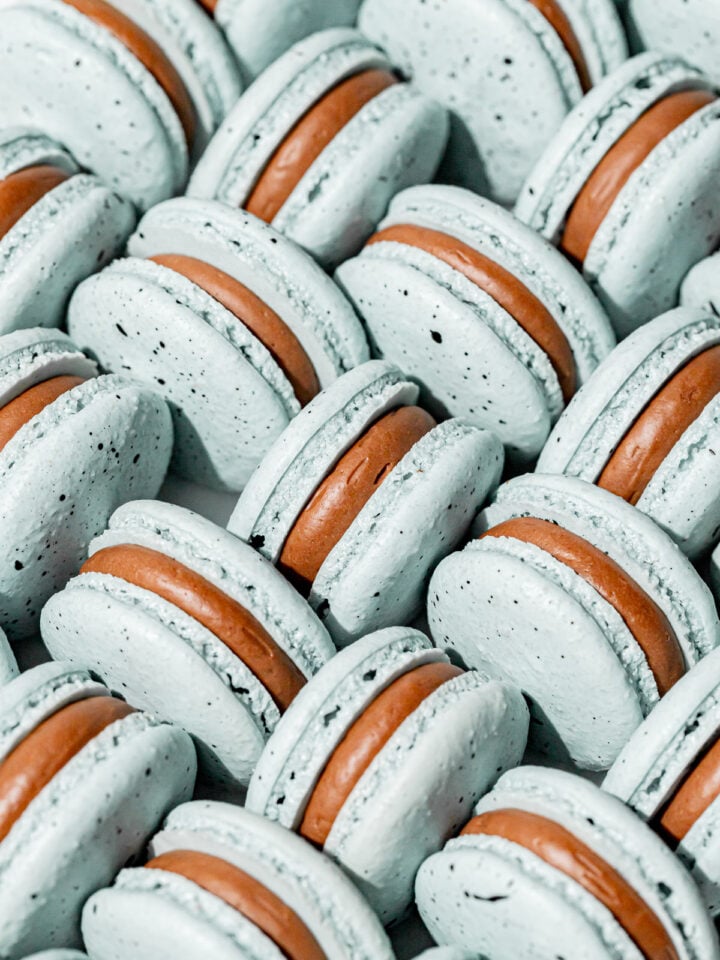
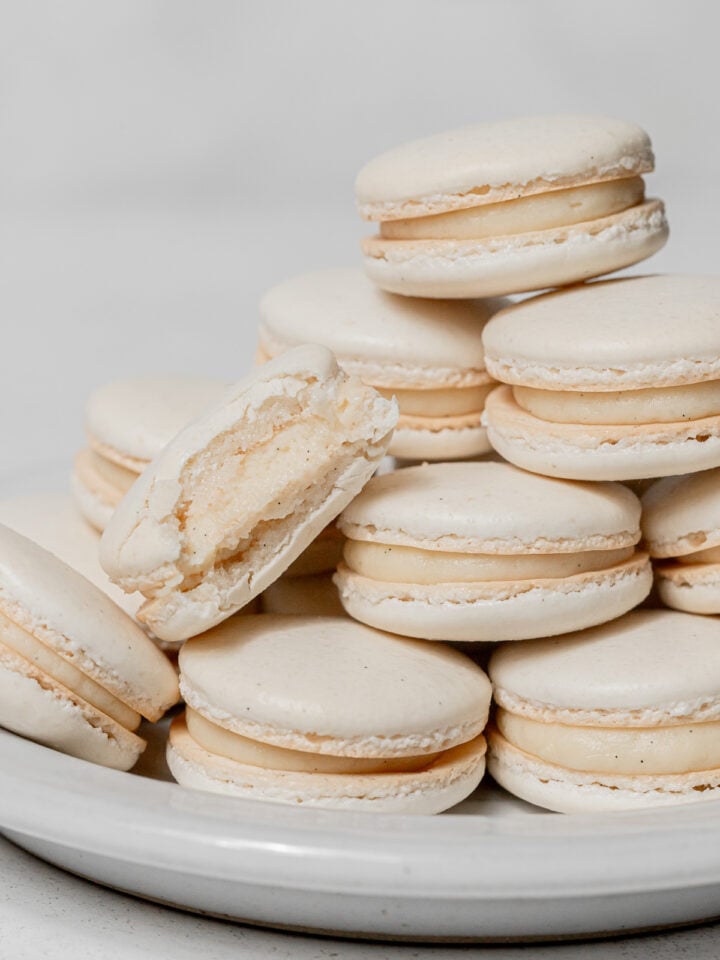
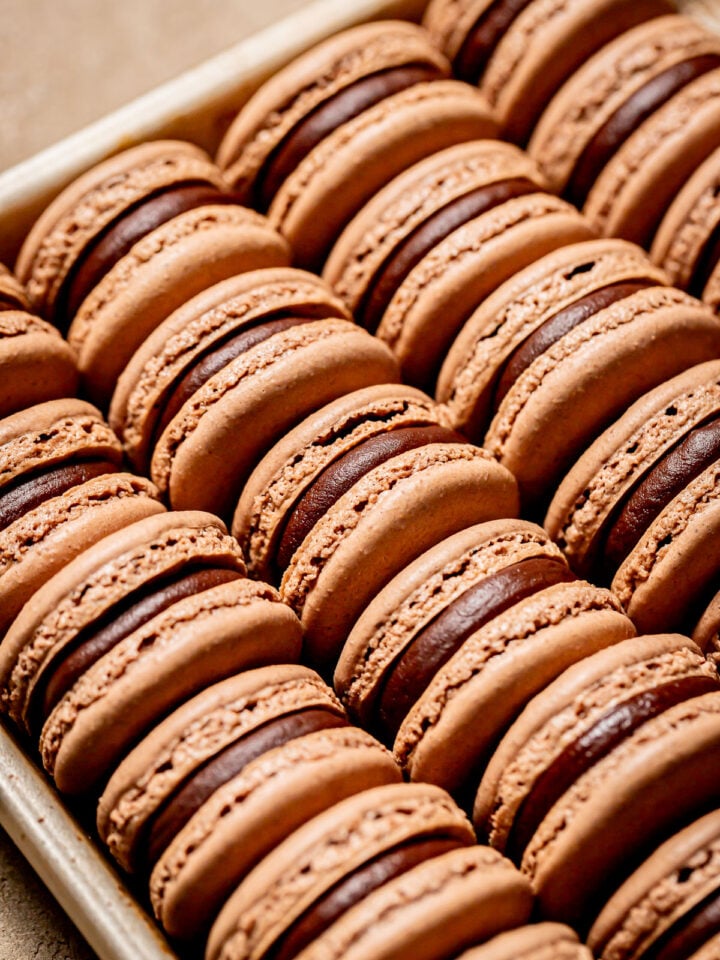
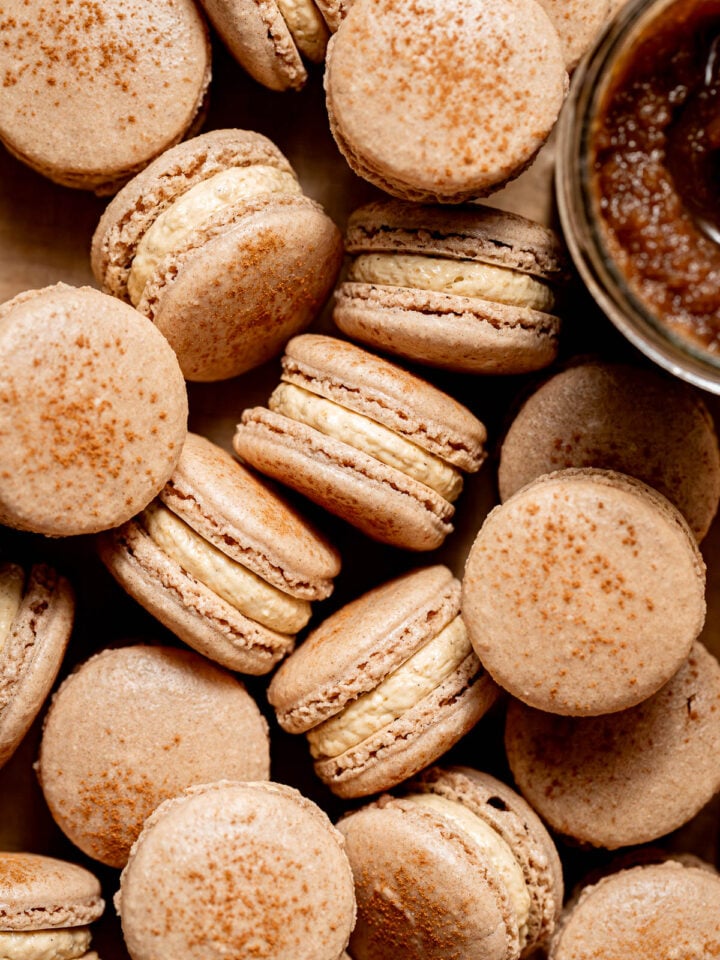
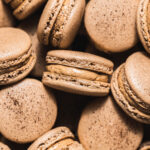
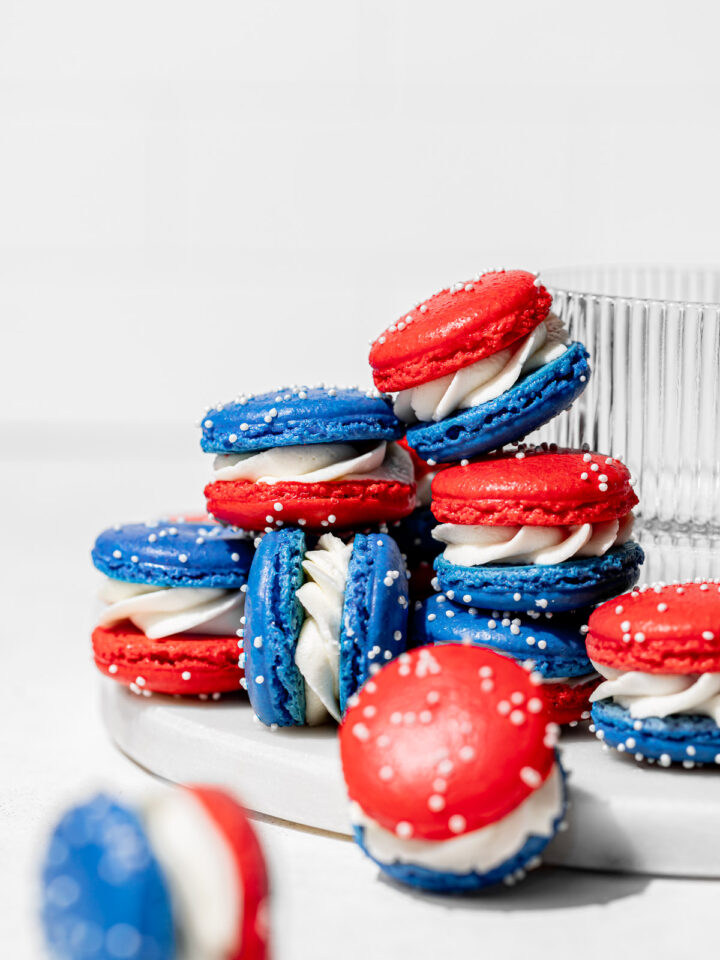
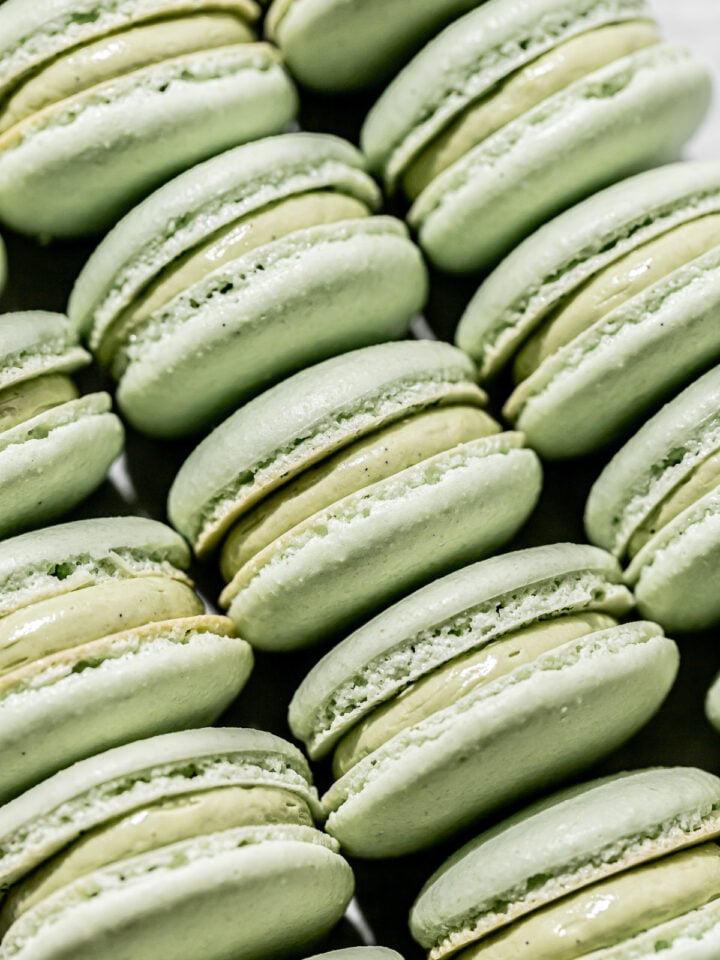
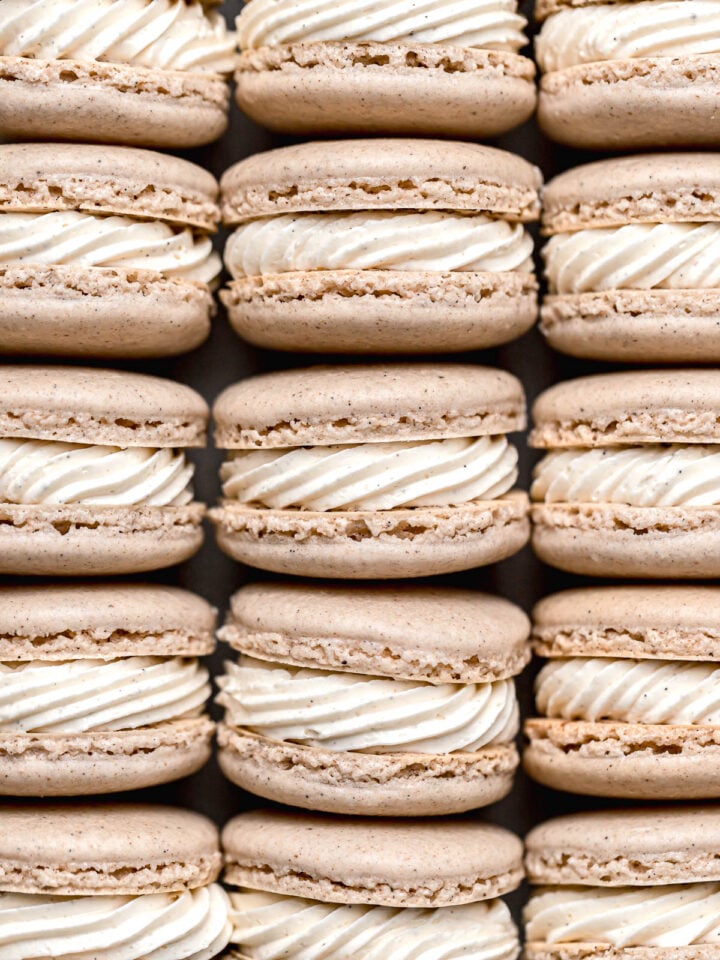
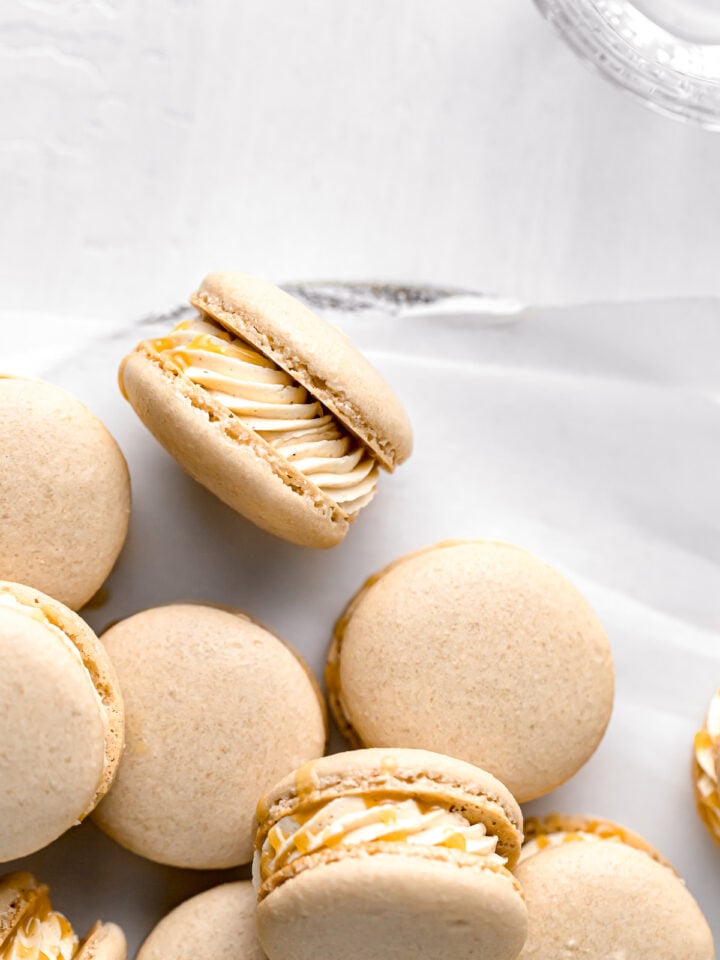
Comments
No Comments